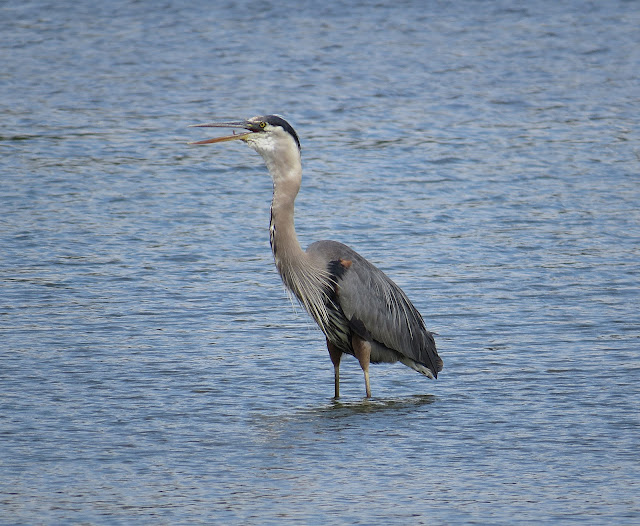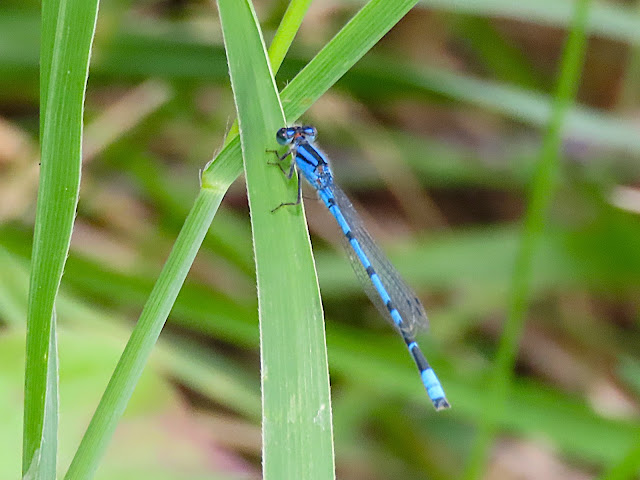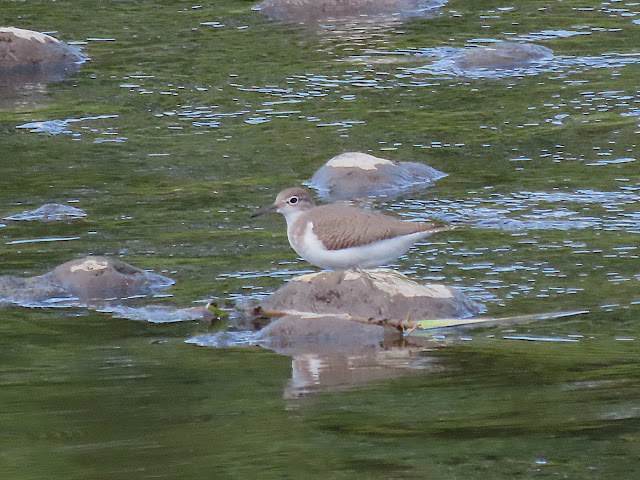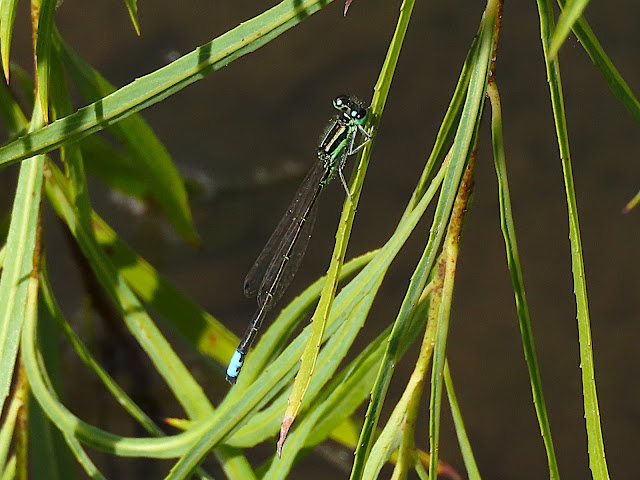25 July, 2024
Columbia Lake is mere minutes from home and always worth a visit.
An Eastern Kingbird (Tyrannus tyrannus) was there to greet us on the fence as soon as we stepped out of the car.
Several Great Blue Herons (Ardea herodias) were seeking food, this one moving stealthily through the reeds.
It seemed to be turning into an Eastern Kingbird day as a family of youngsters was honing their flight skills and insect-catching abilities.
Another heron preferred open water to the cover of the cattails. It was a hot day and it was panting a little.
A Bluet (genus Enallagma) came to rest in front of us, completing a food chain - the frog would make short work of the damselfly and the heron, given the chance, would make a meal of the frog.
Snails such as this one are in the genus Cepaea and it is probably Brown-lipped Snail (Cepaea nemoralis).
We are always delighted to see a Red Milkweed Beetle (Tetraopes tetrophthalmus), a masterpiece of beetle form.
Bird's Foot Trefoil (Lotus corniculatus) seems to carry a copious load of nectar and is a magnet for pollinators such as this Margined Calligrapher (Toxomerus marginatus).
Wild Bergamot (Monarda fistulosa) is attractive in a ragged sort of way, and is a magnet for bees and other insects.
A lone Midland Painted Turtle (Chrysemis picta marginata) was basking on a log, ready to drop back into the water at the slightest sign of danger.
This pair of Bluets was ensuring that their genes would be passed on to a new generation, with the male firmly grasping the female as she lays her eggs.
Jagged Ambush Bugs (genus Phymata) are attractive, yet fearsome and stealthy predators of other insects.
Late summer and early fall are exciting times for birders when the challenging business of identifying shorebirds gets into high gear.
A trio of Mallards (Anas platyrynchos) went about their business, indifferent to the goings-on around them.
We considered ourselves fortunate to spot a Green Heron (Butorides virescens) picking its way along the shore.
Least Sandpiper (Calidris minutilla) is the world's smallest sandpiper and we always take great pleasure in seeing this energetic little warrior.
An Eastern Tiger Swallowtail (Papilio glaucus) seemed to be deriving some benefit from the mud, perhaps essential minerals.
Look at this fine group of Spotted Sandpipers, if you will, lined up on a log, taking a break from the arduous task of feeding.
You will no doubt note that this Northern Leopard Frog (Lithobates pipiens) still retains its tail, a remnant of its transformation from tadpole to frog.
An Eastern Forktail (Ischnura verticalis) was content to just "hang out."
We heard the sharp, far-carrying rattle of a Belted Kingfisher (Megaceryle alcyon) from across the lake and finally spotted four birds, probably a family with the young still under the care of their parents.
As with all things in life we tend to overlook common flowers, and we need a prod once in a while to admire and appreciate those familiar blooms that provide great pleasure. Witness a Red Clover (Trilolium pratense).
It's hard to tell from the following picture, I know, but this is a Red-belted Bumblebee (Bombus ruficinctus).....
















































...the turtle was worth the trip!
ReplyDeleteEs bonito tenen tan buen lugar dcerca de casa. así puedes visitarlo muy a menudo.
ReplyDeleteWonderful nature photos, your post includes so many of my "likes" . It is cool to see the Leopard Frog retaining the tail, I have never noticed that. Take care, have a great weekend.
ReplyDeleteI am so envious of all the lush green! Your first photo is so serene, absolutely frameworthy. Well, they all deserve a frame. So much beauty, there for the seeing.
ReplyDeleteWhat a delightful place to have on your door step - and how wonderful to see so many pollinators as well as the feathered enchantment (not forgetting the frogs and the turtles).
ReplyDeleteDear David,
ReplyDeleteyou discovered a lot of wonderful fauna and flora again.
Oho, and you witnessed the insect Kama Sutra ;-DD
The Northern Leopard Frog already looks so big - that's why I'm surprised that it still has a tail. Is its big appearance an illusion?
Hopefully you had a good time in Algonquin Provincial Park - I'm sure there will be some interesting photos from these days soon!
All the best and have a nice weekend, Traude
https://rostrose.blogspot.com/2024/08/weltreise-2024-neuseeland-sudinsel.html
You see such a nice variety there. I love spotting a Green Heron. They can blend into the background so well.
ReplyDeleteThank you very much for the help with my IDs this week. I have never seen the Northern Parula on this particular trail so that was a nice surprise! Enjoy your Sunday!
DeleteA great variety of birds, flowers, insects, amphibians, and two varieties of heron!
ReplyDeleteSitting by my own little backyard pond this afternoon I was delighted and fascinated to see all the different members of the dragonfly family that it had attracted. Wonderful critters.
ReplyDeleteWhat a great series of photos of nature! That Bluet looks really pretty. My favourite one is that Eastern Tiger Swallowtail on the mud...the texture of mud makes the picture really outstanding. Happy Sunday!
ReplyDeleteThanks, Angie.
DeleteKiitos taas kerran mielenkiintoisista kuvista ja kerronnasta. Joitain lintuja ja kasveja kuvaamistasi lienee myös Suomessa tai ainakin näyttävät samoilta, esimerkiksi pietaryrtti ja kaulushaikara.
ReplyDeleteHello. A nice area where you can see a lot of different insects and birds. Thank you for sharing these great photos.
ReplyDeleteAwesome trip. Great pictures
ReplyDeleteAll is good, love the close up of the frog.
ReplyDeleteThis is a beautiful series of photos David.
ReplyDeleteI love seeing the Sandpipers and the northern leopard frog, I have never seen this type of frog before.
I also think the flowers are beautiful.
I wish you a beautiful Sunday.
Greetings Irma
I'm very late to give you a comment David, but I was away yesterday. I love to see the Wild Bergamot and all the bumblebees. I have many of them in my garden because of all the insects who love them too. The Eastern Tiger Swallowtail is so beautiful. I love all your photos.
ReplyDeleteHugs and kisses, Marit
Hari Om
ReplyDeleteEvery one a jewel! YAM xx
Such a beautiful and informative post. Your photos are incredible and your knowledge is impressive.
ReplyDeleteA beautiful are and wonderful photos! I learn a lot visiting. Thank you very much for identifying all of nature’s bounty.
ReplyDeleteFresh! Refreshing! Here a whole lake has dried up.
ReplyDeleteyes, natures is exciting, in real time or in your photos . that is a prince of a frog and I love the fence in the beginning. the bird to, but the fence grabbed my eye. that is one handsome snail. Hope you are not in the flooding part, we are watching flood news for Ontario but not sure where
ReplyDeleteWe are high and dry, but some areas were inundated. A tornado touched down just south of here, in Ayr, and did some damage.
DeleteHi David.
ReplyDeleteHow wonderful that you live so close to a beautiful nature reserve.
And so much to see.
That King Bird is really beautiful
Beautiful the frogs and the dragonflies
Beautiful butterfly that Tiger Swallowtail.
Greetings from Patricia.
Lucky David to have a beautiful place like this lake nearby....
ReplyDeleteGreat pictures ! As always ;)
Anna
It's always a pleasure to see the many forms of beautiful life that you capture on your excursions. I didn't know herons panted.
ReplyDeleteAll birds do, Shari. The practice is called gular fluttering. Birds don’t sweat so it’s one way they can dissipate body heat.
DeleteWonderful photos! The heron in the cat tails is an amazing shot.
ReplyDeleteWhat a pretty place to walk, and a very prolific place for wildlife viewing too. That frog won't have his tail much longer I'm guessing, and it's a good day to see a kingfisher. Wow, there are lots of sandpipers. We never get them here except at the shore. Happy new week David. hugs-Erika
ReplyDeleteA great collection! I can't believe breeding season is over.
ReplyDeleteso many great photos as usual. and nature's food chain.
ReplyDeleteFantastic collection of photos. I particularly like the frog, it's a beauty.
ReplyDeleteThe dragonflies are a study in themselves. We’ve seen the blue ones several times this year.
ReplyDeleteI have never seen a green heron. That would be pretty special. I guess I have to leave the island though.
Maybe leaving the Island once in a while would be a good thing, Marie. There’s a whole world of nature out there!
DeleteHello David,
ReplyDeleteWe have turtles here too, not naturally but abandoned by people who are fed up with the animals... I really enjoy watching the bumblebees and bees in my garden, and how they bring the nectar and pollen into their breeding tubes... very hard-working animals...
Greetings, Fank
I’d like to abandon some of them! We have non- native Red-eared Sliders here, abandoned by pet owners who tire of their pets. Great people, huh?
DeleteIt's quite lovely viewing through your lens all that nature presents! Love seeing the sandpipers. They are such busy little birds always searching about for food. Great shots of all!
ReplyDeleteNature is the best David. You have some good friends too. What great photos. Those Herons are good, the first hiding and the second out in the open. The Red Milkweed Beetle is gorgeous, I'd like to meet him. Great to see the Damsels, Dragonflies and bees too and the birds. A great selection of lovely creatures :-D
ReplyDeleteIt's obvious that you have to plan your next vacation to southern Ontario, Ananka!
DeleteHello, hello!
ReplyDeletedear friend, good evening! what a pleasure it is to have a sunny day full of life on the lake, every corner has little miracles. This post gives me hope that good weather will come here too at some point jajaja, i ´m below zero and you are so pleased.
Obviously, this is a joke but it is true that the warmth is a bit missed here; on the other hand nature always offers a spectacle worth admiring. Love the original and special snail, it´s a beauty sophisticated.
Happy start of the new week! ع˖⁺ ☁⋆ ୭ 🕊.⋆。⋆ ༶ ⋆˙⊹☁♡🦋 Gros bisous.
It was another lovely trip to your wonderful photos. Green frog is my favourite.
ReplyDeleteYou are lucky to have such an abundance of interesting things to see close by. Love that black bird.
ReplyDeleteI would not dispute that but you still have to get out and look, and so few people seem to do that. We don't have to fight the crowds!
DeleteAs always you have collected a wonderful variety of nature. I always love the dragonflies..I guess the froggies do as well. After I retired from my real job I worked summers in the pond department of a local Garden Center.. We used to sell bull frog tadpoles in all stages of development. That picture brought back memories. Nice shot of the swallowtail. They have been scarce to nonexistent this summer. Sorry that my comment is a little bit late. I was never on my computer this weekend....big hugs xoxo, Missy
ReplyDeleteI have to agree, David, I find the identification of shorebirds more than challenging. I'm glad I I can recognize a sandpiper, but I could never say which kind of sandpiper. Again, I am in awe of your (or Miriam's) photos. I especially like the Red Milkweed Beetle, such a pretty little guy. Is he mainly found on milkweed and that is how he got his name? (just for the ease of writing I'm sticking to the "he" here). Thank you for taking us on another lovely walk of so much beauty. Hugs - Carola
ReplyDeleteA great collection once again. I was visited (fleetingly) by some very large dragonflies yesterday, think spring may be just over the horizon.
ReplyDeleteCheers - Stewart M - Melbourne
Wow, Columbia Lake looks amazing, so many cool creatures, and such beautiful nature! Hope you have an amazing rest of the summer!
ReplyDeletexoxo, MidoriLinea
https://www.midorilinea.com/blogs/midori-linea/panda-village-koala-world
Gusta siempre lo que compartes de la generosa naturaleza. Me gustaron más la libélula azul y precioso el Trilolium pratense. Y que bien saben almorzar los insectos en las flores. Volviendo amigo, he estado un poco alejada.
ReplyDeleteOs deseo buena semana.
Un abrazo.
Too many wonders to mention today and how lovely this area is so close to home. I love the turtle;) I call Monarda Bad Hair Day Flowers:) And I always wonder if the early plane pioneers used the dragonflies or their relatives for their blueprints :) Have a grand one.
ReplyDeleteMaravillosa naturaleza, espero que se conserve así siempre. Estos días está llegando humo a España, que dicen que viene de Canadá, espero que todo esté bien por ahí ¡ odio los incendios ! Abrazos.
ReplyDeleteKolejny piękny spacer nad wodą. Podziwiam piękne przyrodnicze kadry z fauna i florą. Piękna ważka Plathemis lydia!
ReplyDeleteI don't know why I think that the photos in here are touching me more than they usually do, but they're wonderful. Of course you know I'm a heron woman but every one seems to speak to me today.
ReplyDeleteHi DAVID,
ReplyDelete"mere minutes from home and always worth a visit." That is luxury! A place to cherish and so wonderful when there is so much to see! Beautiful nature shots. The encounter with the Green Heron is gorgeous.
Regards Maria